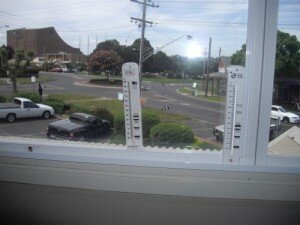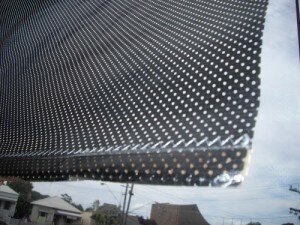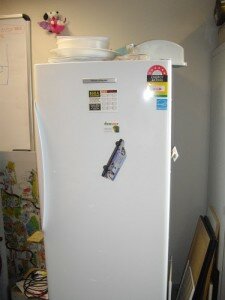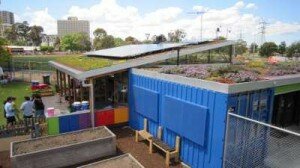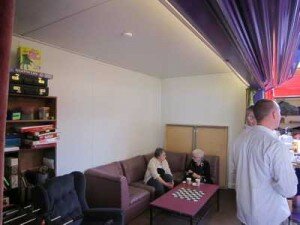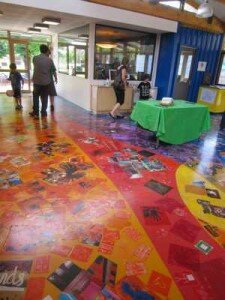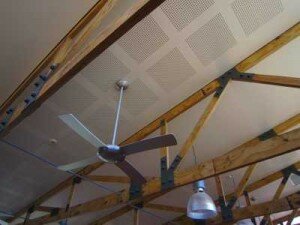Reports recently published in newspapers indicate that the government’s mandatory energy star rating schemes of homes is rather inaccurate. The scheme has been heavily-criticised by the building industry (HIA and MBA) and they are calling on scientists and the Department of Climate Change and Energy Efficiency to review the way the star rating is calculated for new houses.
Baw Baw Shire council cuts electricity use by 30% in a rented office.
Last week I caught up with Raj Maniher of Baw Baw shire council in their Smith Street Community Development office that council is renting in Warragul. Raj has implemented a number of measures to cut energy use in the office, and has achieved a 30% electricity saving.
Some of the measures implemented include:
Insulating the ceiling
Double glazing using “magnetite” on some of the windows.
Getting internal reflective blinds made up by a local blind maker. Very ingeneous!
Voltage reduction on the lights
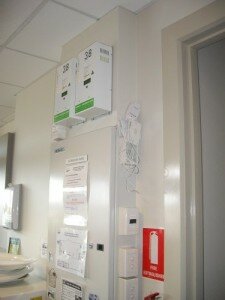
Voltage reduction units on lighting circuits
Blanking off light fittings with a clear Perspex sheet to prevent air leakage into the ceiling cavity.
Disconnecting inefficient lights and replacing with fluorescent
Upgrading to a 5 star fridge
Only switching on when needed – for example the airconditioner, and kitchen equipment is turned off at the wall when not in use.
Delamping
How would you save energy in your rented office?
The Venny – a sensible low energy building with an experimental green roof
On the weekend I attended the opening of the new Venny, an adventure playground for children from the ages of 5 to 16 in Kensington near the public housing estate.
The new Venny replaces an older building, and from an energy perspective has outstanding, passive-solar design. I’d encourage other local governments to learn from the Venny with any new community facilities they are building. The key principles being:
- High levels of insulation, properly installed
- A well sealed building
- Lots of thermal mass, and a night purge system, to harness diurnal temperature swings rather than fighting them as is done in conventional building design.
- Good solar orientation.
- Solar PV to provide building energy needs.
Project architect Ralph Webster, from the City of Melbourne, summarises the building design
Ralph Weber talks about the Venny (video, 5:40)
Key energy efficient features of the building design are:
- The green roof.
Coupled with the foam “sandwich panel” ceiling, the R rating of the roof is estimated to be around 11 – or nearly 3 times that of most roofs. Foam sandwich panel construction has a key advantage over batts in that its much less likely to be poorly installed, reducing insulation effectiveness.
- A 5.5 kW solar PV system
- The 50 mm foam insulation on the inside of the shipping containers around the building, including sandwich panel on the roof to improve its strength and ability to take the load of the green roof.
- The high quality windows, with an aluminium weather proof external finish, but the rest timber (so the frame provides a good thermal break). Glazing is double, low-e, with argon fill.
- High thermal mass in the concrete floor. The floor is spectacular, a key feature of the building, incorporating children’s art, building plans, etc, encapsulated in the floor with a clear resin coating. (I’m not sure how the coating influences the performance of the thermal mass)
- Use of a phase change material (PCM) in the plaster. A 10mm plaster thickness essentially has the same thermal mass as a 90mm brick. The PCM is a BASF product called Micronel, that is encapsulated in the plaster. At 26 degrees it changes phase from a solid to a liquid, absorbing a lot of energy as it does so (just like making ice requires a lot of energy).
- Sensor controlled lighting, which is a combination of metal halide and T5.
- Aggressive occupancy sensor timing settings on the toilet lights and fan, with a 5 minute timeout.
- A night purge. This is used to “recharge” the PCM in the plaster. So for example on a hot summer’s day the PCM may have all melted. By having cool air pass through the building at night it “recharges” (ie solidifies) the PCM. The night purge consists of a couple of windows that open at ground level and a ceiling vent that opens at night. There is provision to install a fan if necessary. The use of a night purge has been the single best feature of Council House 2.
- Ceiling fans to provide cooling via air movement if necessary
- High efficiency gas wall heater with a balanced flue.
- Exact due North orientation, minimal use of east and west glazing.
- Focus on recycling materials (such as shipping containers) for low embodied energy.
CarbonetiX has been involved with the Venny with the provision of a real time monitoring system to track site electricity consumption and solar electricity production, and also to monitor performance of the green roof. Three different substrates have been used in the green roof on a trial basis. We have put temperature sensors in the substrates and are also measuring water use to each section of the roof. This will be used to help evaluate the performance of the different substrates, which is a research project being undertaken by the University of Melbourne.
The hope is that the building will be a net exporter of energy. What I particularly like about the Venny is its sensible passive solar design, and reliance on simple control (just using the fire panel). Its easier to keep energy use low in a building where the controls are simple and easy to understand.
I would like to install some more sensors to monitor and understand the Venny’s thermal and energy performance in more detail, and Ralph is happy for us to do this, with the University of Melbourne probably available to assist with installation and data analysis. This will help us better understand the effect of the various factors that interact to determine the whole building performance, of use when looking at retrofit options for existing buildings.
If you know of anyone who might have research funding available for this let me know!
And if you are building a new community facility, please get us involved. I have a great personal interest in zero energy buildings, which I believe are possible with today’s technology. With good design believe a zero net energy building can be cost competitive with more conventional, energy inefficient, construction.
LED comments by an early innovator
Mal Oldis, an earlier innovator with LEDS, contacted me recently with the following comments on our report LED as a fluorescent substitute:
I have read with interest your assessment of LED lighting vs Fluorescent lighting. Well done!!
I have done much work with LEDs and yes, much credibility is lost due to false and exaggerated claims.
Indeed a company for which I was in charge of product development, failed partly due to exaggerated claims.
I probably built the first LED replacement (in Australia) for a T8 over 10 years ago.
I learn t much from Agilent’s LED division in San Jose and also from the team at Philips in Holland.
Can I comment on your (very good) report?
I am not suggesting that you do not understand these issues, but there is some technical issues that commonly do not seemed to be explained to potential LED users.
Life time issues. Rated life time for LEDs and Fluorescent lamps is very different but the same term is used.
Rated life time of fluorescent lamps is usually stared time taken (under specified switching cycles) for half the lamps (median life) to fail.
Between 6 to 30 thousand hours are possible.
The rated life under these conditions for most LEDs is around 1.4 million hours. The “life time” quoted for LEDs of say 50,000 hours (typical for white) is the 50% radiant (photometric) output level. It is interesting to note move to 70% output as noted in your report.
It is common to use the LOR (Light Output Ratio) figure for luminair directly. Also lumen maintenance can vary considerably for a luminair that uses fluorescent lamp due to dust and other contamination on the tube and the reflector, which forms part of the secondary optics.
Any secondary optics (diffusers etc) using LEDs is simpler and therefore more efficient.
When I talk of the economics of LED lamps, I create an economic model and refer to cost of ownership which includes various maintenance regimes.
Also there is often no mention of the spectral properties, notably the Color Rendering Index which is poor for Fluorescent and even poorer in LEDs.
I did the original engineering for the BP Neon replacement for the service station canopies, and did much work with the City of Port Phillip using LEDs for public lighting.
Cheers,
Mal Oldis.
Greenwashing and carbon accounting standards
I’ve been invited to comment on a recent article by Hunter Richards of Software Advice on greenwash. The article calls for an improvement to environmental accounting infrastructure through software, so that consumers can have greater confidence in claims of carbon neutrality. Financial accounting methods, standards, auditing procedures and tools are well developed, but not so with carbon accounting. By way of example Richards highlights how a well known company that stated it was carbon neutral hadn’t accounted for its scope 3 emissions.
Scope 3 emission are “indirect” emissions that are embodied in products and services that a company may use. For example scope 3 emissions for a drinks manufacturer would be the carbon emission embodied in the aluminium the drinks company makes its cans out of. However the Greenhouse Gas Protocol, the major global carbon accounting standard in use, hasn’t yet prescribed inclusion of scope 3 emissions in carbon accounting practices
Scope 3 emissions are challenging to measure, and ultimately can only be accurately tracked if every product is labelled with its embodied carbon emissions. Financial accounting practices rely on everything having a price. For example, the sale price of a car is comprised of the cost of everything that goes into making the car, down to the wheel nuts. The price of the wheel nuts in turn depends on the price of the steel used to make the nuts, and the amortised cost of the tooling used to make the nuts. The price of the steel depends on the ingredients in the steel, for example its molybdemum content, amongst others. The price of molybdemum depends on the cost of energy and labour and amortised machinery used to mine it, process it and transport it. The amortised price of mining machinery depends on many factors as well. Ultimately there are probably well over a million prices that come together to make up the price of a car. In the same way complete carbon accounting also relies on every product or service having emissions associated with it accounted for.
This is complex to do. Daniel Goleman’s book Ecological Intelligence gives the example of glass, which typically has over one hundred ingredients in it in addition to sand. To provide thorough scope 3 carbon accounting requires being able to identify the emissions arising from each ingredient. Thorough scope 3 accounting for something like a computer or a mobile phone is thus very hard to do if the embodied emissions of each constituent part is not known. In the absences of mandated carbon labelling for all products and services, voluntary carbon reporting of scope 3 emissions is very challenging.
This is where emissions databases, and associated software, are useful. “Generic” emission factors could be developed for a particular type and size of product or service, in the absence of actual numbers, and applied when estimating scope 3 emissions. Global sharing of this information via on-line databases could make scope 3 carbon accounting much easier. However generic emission factors will only ever be rough approximations. Ultimately if accuracy is the aim everything in the economy needs to be labelled with its carbon emissions.
Standards, auditing standards, certification schemes and clear rules are needed for accurate carbon accounting. In the absence of complete carbon labelling of everything there needs to be transparency around methodologies and recognition that scope 3 carbon accounts will at best be estimates with a long list of assumptions behind them.
The Victorian Climate Change White Paper Implementation Plan
The Victorian State Government’s Climate Change White Paper – Implementation Plan, shows determination to reduce the state’s greenhouse gas emissions, with the aim of lowering emissions by 20% compared with 2000 levels, whether or not there is global agreement on greenhouse gas abatement targets. Around the world other states and countries have also set abatement targets. California has set a target of returning to 1990 emissions by 2020. And the UK aims to reduce emissions by 34% relative to 1990 levels.
In the White Paper 10 action areas for achieving this target are mapped out, which are:
- Climate change legislation to cut greenhouse pollution by 20% – The Climate Change Act, which passed state parliament in September .
- Moving towards a cleaner energy mix. This includes the prohibition of the construction of brown coal power stations, and also a commitment for emissions from existing brown coal powered stations to be reduced.
- Investment in renewable and clean energy in Australia. It has the vision of making Australia the “solar state” with 5% of our power to come from solar energy by 2020, and of bringing in a large scale solar feed in tariff. In 2010 93% of Victoria’s power comes from brown coal, by 2020 the aim is that this will be reduced to 60%, with the rest coming from wind (20%), natural gas (15%) and solar (5%).
- Support cleaner and more efficient homes. This will be achieved via expansion of the VEET (Victorian Energy Efficiency Taskforce) scheme and by requiring all homes to be 5 star by 2020.
- Positioning Victoria to be a global clean tech leader by 2015. This sees leadership in the area of carbon finance and in helping business reduce its carbon emissions. It doesn’t have any particular focus on a specific area (eg energy efficient buildings in a temperate climate). It sees skills developing in the areas of low energy homes
- Creating new opportunities in agriculture, food and forestry, with a focus on carbon offsets, lower carbon agricultural practices and soil carbon sequestration. A Victorian carbon exchange will be developed whereby these offsets can be voluntarily purchased.
- Delivering innovative transport solutions. This has a focus towards moving the transport of people and freight from motor vehicles to public transport and rail, and supporting vehicle technology with lower emissions.
- Greening government. This has a focus on increasing greenpower purchases, reducing energy use in buildings through an energy performance contract model and installing cogeneration systems in hospitals. It also provides support to local government
- Helping Victorians adapt to climate change, particularly in adapting to the effects of heat, floods and drought, and also in researching and understanding better the long term impacts of climate change, in particular along the coastline.
- Strengthening “Climate Communities.” This provides grants to community groups through the Climate Communities program. The AuSSI Vic Resource Smart Schools program will also be extended to all government schools.
Access the Whitepaper at http://www.climatecommunities.vic.gov.au/
Government funding for “disruptive and innovative” energy efficiency
The US government has set up a special agency within the Department of Energy called the Advanced Research Projects Agency (ARPA) to promote “Disruptive and Innovative Approaches” to clean technology. ARPA has the following objectives (from the ARPA website):
- To bring a freshness, excitement, and sense of mission to energy research that will attract many of the U.S.’s best and brightest minds—those of experienced scientists and engineers, and, especially, those of students and young researchers, including persons in the entrepreneurial world;
- To focus on creative “out-of-the-box” transformational energy research that industry by itself cannot or will not support due to its high risk but where success would provide dramatic benefits for the nation;
- To utilize an ARPA-like organization that is flat, nimble, and sparse, capable of sustaining for long periods of time those projects whose promise remains real, while phasing out programs that do not prove to be as promising as anticipated; and
- To create a new tool to bridge the gap between basic energy research and development/industrial innovation.
ARPA is currently supporting R&D in the following areas:
- Better batteries
- Technologies the reduce carbon emissions in coal powered power stations
- Grid scale energy storage
- Material advances in magnetic, high voltage switching and charge storage.
- Electrofuels – microorganisms to harness energy and convert carbon dioxide into liquid fuels
- Energy efficient building cooling technologies
This is an exciting program, and I particularly like the focus on breakthrough technologies. For example one of the energy efficiency cooling technology projects ARPA is supporting is thermoelastic cooling. This is a space cooling system that could have a a COP (coefficient of performance) up to 175% better than current vapour compression refrigerant systems.
It would be great to have a program similar to ARPA here in Australia.
Wanted – A Leader To Develop Australia’s First Retrofitted Zero Net Energy Building
For around a year now I’ve been fascinated with the idea of being able to convert a building to zero net energy. To my knowledge, there is not one commercial building in Australia that has been converted to zero net energy use. Its challenging, but not impossible. I’m looking for someone who wants to take up the challenge with me and demonstrate leadership in what can be done with existing buildings.
A revolution in energy efficient commuting – 20 km/hr for just 35 watts!

shweeb monorail bicycle
Shweeb, a NZ company, has come up with a fantastic low energy commuting concept that could transform our city scapes. Its based on a monorail concept under which an enclosed recumbent bicycle operates. The aerodynamic fairing reduces wind resistance, and as the rollers are steel on steel (a bit lot a railway) rolling resistance is very low. Its absolutely brilliant!
Check out the shweeb website:
http://shweeb.com
If you are a cyclist you’ll really appreciate the following elements of the shweeb concept:
- Its more efficient than a bicycle. Being able to travel at 20 km/hr whilst only producing 35 watts of power is very efficient.
- Its comfortable (recumbent’s are much more comfortable that normal bikes)
- You don’t get a sweaty back when carrying a back pack
- You stay dry
- You are out of traffic
Will the shweeb concept take off? Whilst the advantages are considerable, it does require a significant investment in infrastructure. As the shweeb network requires staffing, there will also be ongoing operational costs. Its best initial application is for high density areas with lots of commuters travelling the same route every day and poor existing public transport.
If you are in a government (local, state or federal), in a high density area with a lot of commuters and poor public transport consider the shweeb concept!
Raising the profile of energy efficiency
Last week I attended the All Energy conference in Melbourne. Running over 2 days, with over 30 conference sessions, just one was dedicated to energy efficiency. Rob Murray Leach, head of the Energy Efficiency Council who chaired the session, kicked it off by saying that this was the most important session of the conference, as 65% of the world’s carbon reduction by 2020 to come from energy efficiency according to the International Energy Agency.
But is energy efficiency getting 65% of the press coverage, is it 65% of the conversation around 2020 carbon abatement targets? Clearly it isn’t.
There is a massive vacuum when it comes to awareness and understanding of the most cost effective way by far of reducing carbon emissions – energy efficiency. Have a conversation about reducing your carbon footprint, and the first thing to come up will be solar panels, not building controls.
Yet from an economic perspective energy efficiency is extraordinarily interesting in comparison with solar. At commercial electricity tariffs, without subsidies, even the cheapest solar PV system has a payback of over 25 years.
Cover the entire roof of a typical two or three storey office building with solar panels and you’ll reduce electricity usage at the site by around 15%, whilst spending about four times your annual electricity costs to buy the solar system. Yet energy efficiency could probably deliver that same 15% saving with a 2 to 3 year return on investment.
So why isn’t energy efficiency getting the attention it deserves?
As an industry we haven’t been effective in promoting energy efficiency. The recently formed Energy Efficiency Council, of which CarbonetiX is a member, is now taking up this challenge, but there is a long way to go.
Energy efficiency is not visible. The results of changes to the lights and the way the air conditioning is controlled are only visible to the person paying the much lower energy bills, and the person who championed the changes. Solar panels are visible to everyone.
The invisibility of energy efficiency is compounded by the fact that the good news stories aren’t told. They may not even be told to people in the building where the savings have been achieved, let alone to the wider public.
And energy efficiency, whilst it gets good savings, is not that easy to do, but there is a perception that it is easy. So organisations may undertake a DIY approach, with no training and no experience, and not achieve any noticeable savings. A classic DIY approach would be to spend $2,000 to get occupancy sensors fitted to control the lights in the toilets – I’m sorry but the savings from this simply won’t show up in your energy bills.
The problem arising from failed DIY efforts is that this then creates the perception that energy efficiency doesn’t work. And nothing could be further from the truth. Yes, energy efficiency does work, but you need to know what you are doing. Businesses don’t get the receptionist to do their tax return. A qualified, experienced accountant who is normally contracted to do so. But when it comes to saving energy, all too often its assumed that an environmental officer or a facility maintenance officer can effectively do energy efficiency.
So, to raise the profile of energy efficiency, celebrate and promote the savings you achieve. Put up a plaque above reception showing how much you have saved, or a graph of how your energy use has gone down. Get a high NABERS rating and put the certificate in reception as well. Talk about what was done to use the savings. Get a case study done and circulate it amongst your staff. Then send the case study off to your local paper and get them to do a profile on what you have achieved.
And to get those savings, to make energy efficiency really work for you, get expert advice and guidance.

